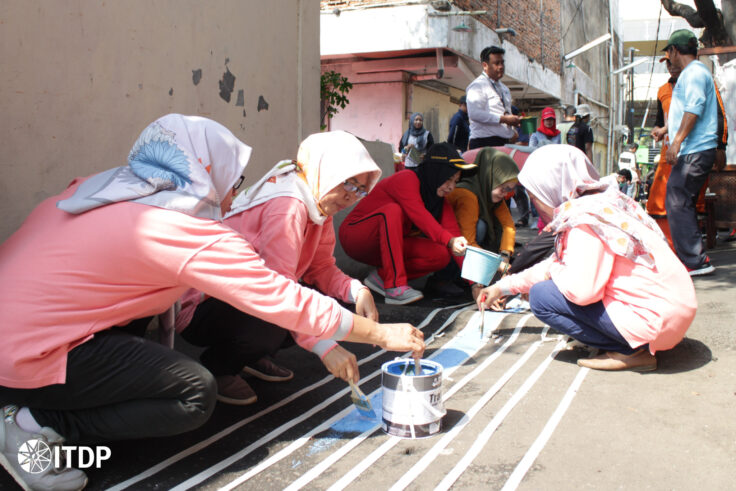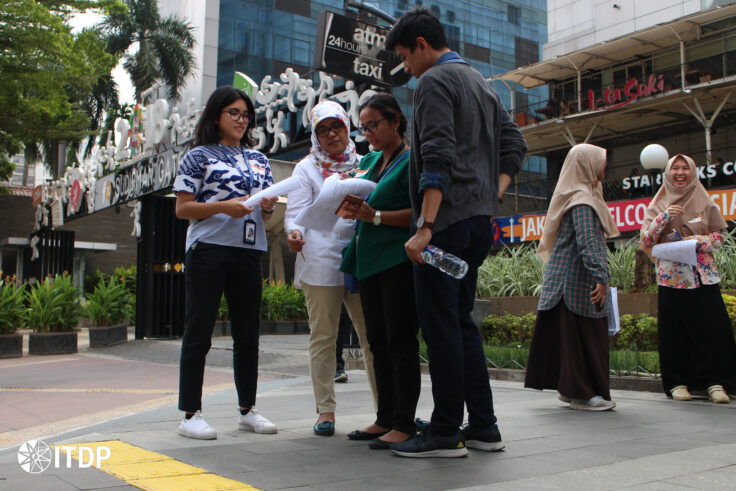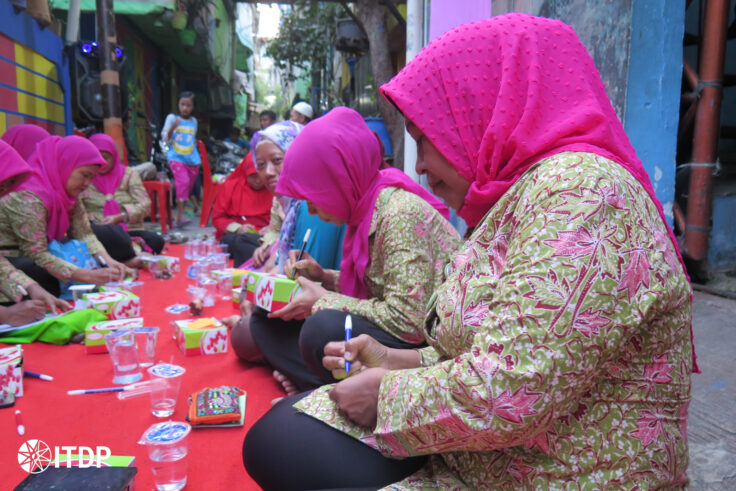March 08, 2024
In Indonesia, Women’s Inclusion in the Urban Planning Process is Essential
Direct community involvement in urban planning processes is stipulated in Indonesia’s National Development Planning System through Musrenbang, or a ‘Multi-Stakeholder Consultation Forum for Development Planning’.
The Forum is organized to accommodate the needs and perspectives of various stakeholders affected by existing and potential national and regional urban development plans. This can range from issues of broader government policy to more localized community planning efforts. Unfortunately, women and other vulnerable groups are not explicitly mentioned in the Musrenbang. Based on ITDP Indonesia’s observations through Kampung Kota Bersama, an ITDP initiative focused on community engagement and sustainable mobility, Musrenbang forums across the Neighborhood and the Community Association (RT/RW) levels, sub-districts, and villages rarely involve women. Women’s presence and engagement could and should be much more extensive in these forums, and it is critical to dispel regional beliefs that women are not well-versed in technical matters. These barriers have often limited women’s participation in urban planning, especially in public transport, and perpetuates policies and infrastructure that are not created with gender equity and accessibility in mind.
The absence of women’s voices in urban planning processes, especially when it comes to urban mobility, has created inhospitable and unsafe built environments for women in Indonesia and beyond. In addition to safety and security issues, inhospitable cities for women cause financial losses and potentially increases vulnerability to harassment and violence. For example, women often spend of their resources on daily transport than their male counterparts. According to the UN Women’s Scoping Study in 2018, many women do not take up new job opportunities or promotions because the work often occurs at or ends at night time. Due to the absence of cheap, safe, and secure transport services at night, many women are unable to expand economic and social opportunities. So, in the Indonesian context, how can governments involve more women in urban planning processes?

From ‘Joint Audits’ to ‘Urun Rembuk’
In ITDP Indonesia’s implementation of public transport planning activities, several methods have been used to ensure women’s involvement and engagement which can also be. In 2017, ITDP Indonesia collaborated with UN Women Indonesia and Transjakarta to organize ‘Safe Bus Journey‘ activities. In this activity, participants were invited to walk on the sidewalk and use Transjakarta buses to identify their obstacles in traveling. Afterward, a two-way dialogue was held to learn more about the participants’ concerns about using public transport, with a particular eye towards gender-related issues. This method was also used in other initiatives undertaken by ITDP to further spotlight the experiences of women and the need to include them in urban policy descisions (see Women and The City, 2018, and the Puan-Puan Bersepeda initiative, 2022).
Another method utilized by ITDP Indonesia is the ‘joint audit’ that is aimed at scoring infrastructure. Before conducting the audit, women are provided with guidelines on using the auditing tool through workshops, training, or manual distribution. This method is more comprehensive than traditional formats, and digital applications can be utilized as well, such as the MySafetipin app. ITDP Indonesia collaborated with UN Women Indonesia in 2018 using MySafetipin to conduct limited audits on new sidewalk infrastructure in Jakarta.


One-on-one interviews and journaling for community outreach can also provide freedom of expression for women to catalogue their concerns, opinions, and suggestions for urban solutions without fear, embarrassment, or hesitation. The implementation of this method begins with an explanation of the topic, guiding questions, and samples. This method is essential to getting as many women’s feedback as possible. Responses and unique notes from interviews and journaling may not be related to the main issues raised but, upon examination, reveal related factors. For instance, in implementing Kampung Kota Bersama projects in one of the Community Associations (RWs) in North Jakarta, a woman’s journal pointed out animal refuse in the alleys as a factor that prevented her from walking. In addition, a note about a pile of goods in one corner of the alley changed a women’s perception of safety when crossing, especially when walking alone in the dark. Taken together, these nuances reveal broader issues of street maintenance and safety that need to be addressed for equitable mobility.
In Kampung Kota Bersama, a ‘urun rembuk’ (or collaboration) forum was held as a joint discussion among the groups. This activity was conducted after the team received data through a joint survey, interview, and journaling activities. The method of implementing clustered group discussions was used to contrast, confirm, and agree on the formulation of problems and solutions offered. The exciting part is that in practice, in 27 urban villages in Jakarta, this method and forum helped to mainstream gender issues to be easier for men to also understand. Another useful method is to conduct a co-planning and co-design process that includes mapping, planning, and designing spaces and built environments. This process can be done by preparing media, such as printed maps, to be produced collaboratively. Practically, it also includes measuring and structuring the space to be planned. The above methods can be combined in more than one participative process.
Regardless of the method used for engagement, it is also important to remember that the choices of location and timing strongly influences women’s participation. Hence, flexibility in timing and availability of the method of implementation in spaces often used by women is essential. Instead of creating a forum and inviting women to attend, bringing activities to ‘posbindu services’, ‘posyandu‘, or women’s social gatherings could facilitate more direct participation. Collaboration with other community and localized groups can also facilitate interviews, dissemination of survey forms, or daily trip notes. Using multiple outreach methods will have a larger impact in terms of the level of involvement of women in urban planning processes, as it not only places women as objects of planning but also as the subjects. This engagement ensures women can occupy important positions as urban planning experts, decision-makers, and users of urban space simultaneously.
Ultimately, the absence of Indonesian women’s perspectives in urban planning, design, and data collection results in more inaccessible spaces for everyone. The development of transport policies and strategies with a gender equity lens is not just possible, it is essential the future of our cities and communities.
